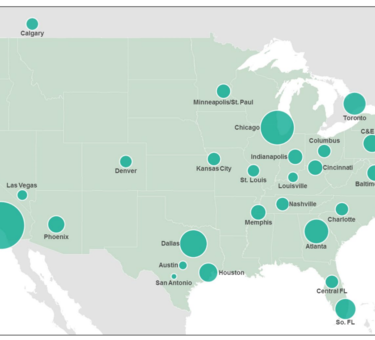
The modern supply chain is both local and global. Trade patterns have become increasingly sophisticated in the last 20 years, driven by shifts in where goods are produced and consumed. These evolving patterns, along with advances in technology and e-commerce, have reinforced the value proposition of core market locations and have rendered certain building types and locations less desirable or, even, obsolete (for more information on the implications of obsolescence please click here).
In this paper, we:
- explain the concept of logistics clusters;
- identify the demand drivers in logistics clusters;
- introduce a proprietary indicator designed to measure the relative size and competitive advantage of logistics markets; and
- measure the evolution of these clusters in developed and emerging economies.
Recognizing how logistics clusters evolve provides a deeper understanding of which locations are poised for outsized growth over the next decade. Prologis defines a logistics cluster as an agglomeration of distribution centers concentrated to serve local consumption and/or global trade routes. Often, location clusters operate irrespective of governmental boundaries. This means that a cluster might include adjacent markets or metropolitan statistical areas. We define modern stock as facilities that meet a combination of superior and often enduring locations and suitable functional features such as ceiling heights. Building characteristics will vary by region depending on the maturity of the regional supply chain. Many clusters have elevated demand growth rates and our analysis finds that the increasing demand for modern logistics facilities plays an important role in that growth.
We find substantial differences around the world. Customers are importing global best practices to realize synergies and cost savings in their supply chains. Although on the rise, many of these clusters continue to see low levels of modern logistics stock, which creates the potential for significant demand and development. Continental differences across the size and growth of logistics clusters generally arise from variances of the adoption rate of modern logistics facilities, which is underpinned by meaningfully different timing when customers begin to adopt modern facilities. In the long term, we do not expect homogenous supply chains and logistics clusters, as local owner-user rates, breadth of functional Class-B properties and other key idiosyncrasies in logistics clusters (e.g., zoning, development constraints, etc.) influence the size and growth of logistics clusters.
I. THE RISE OF GLOBAL LOGISTICS CLUSTERS
The logistics real estate market is increasingly a global business, following from the footprint of its major customers. Modern logistics facilities – those with advanced functional features and/or superior locations near transit infrastructure or major population bases – are a relatively new phenomenon. We have seen a rise of logistics clusters – markets with a notable concentration of modern facilities – emerge and gain footing over the past two decades. Customers are importing supply chain best practices from regions where the business of modern logistics real estate is more mature, principally in North America. This modernization fuels elevated demand in developed and emerging economies alike. Based on our review of established and new logistics clusters, we have identified the three main factors that shape the size of logistics clusters:
- Consumers: Size and growth of the local consumer population
- Trade: Geographic positioning and importance along global trade routes
- Modernization: Supply chain maturity and the adoption rate of modern logistics facilities
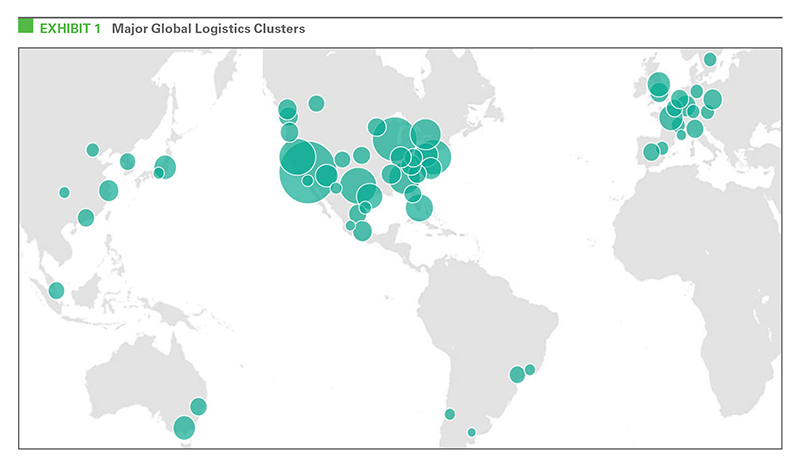
The growth of consumer classes around the world is the primary driver of the rise of logistics demand. Employment and wage growth in the local economy are often the most closely correlated metrics to demand growth in clusters oriented toward distribution to consumers. The rapid rise of consumption in a local economy is generally driven by the structural emergence of the middle class, which in turn drives a rapid increase of logistics real estate to service the middle class. Relative size differences between markets typically are best explained by the relative size difference of the local consumer base. However, two drivers – trade and modernization – also drive considerable differences within regions and around the world.
Geographic positioning along global trade routes also drives the formation of logistics clusters. Often, the flow of global trade coincides with local consumption. As such, distinguishing the effect of trade on market growth can be difficult. Proximity to value-added light assembly and parts suppliers can be a driver of logistics demand in trade-oriented clusters.1 The best examples of global trade-driven clusters are moderately sized local economies with outsized logistics stock, such as the Southern Netherlands and the Northern Mexico markets along the U.S. border. Large economies can rely on trade routes, too, with Southern California the best example.
Consumer- and trade-oriented logistics clusters depend on physical infrastructure to properly operate and grow. Adequate roadways and proximity to highway interchanges can determine the relative size of consumer-oriented clusters. In addition, access to rail intermodals, seaports and airports clearly shape the relative scale of trade-oriented clusters.
The modernization of supply chains and the adoption of modern logistics real estate is an important driver of growth in many clusters. Modern logistics stock is relatively nascent around the world compared to North American standards. As retailers and distributors implement supply chain best practices, industrial clusters modernize, creating demand that can persist independent of economic cycles. This supply chain evolution is visible in clusters now unfolding in emerging and developed economies.
Supply chain maturity and the adoption of modern logistics facilities are vastly different around the world. The U.S. supply chain is among the most mature. Retailers and distributors have planned for and operated as one market for 50 years, following on the heels of the interstate highway system and the deregulation of trucking and rail in the 1960s and 1970s. In contrast, the reversing of trade flows in Japan, with a greater reliance on imports and local distribution, is a relatively recent phenomenon. Similarly, the rise of the euro and the decline of trade barriers across Europe in the past 20 years have been catalysts for change in the organization of distribution in Continental Europe. Of note, the rise of consumer classes in emerging markets prompts demand for modern logistics stock where previously there was none. To illustrate, modern logistics stock in the greater Shanghai area has risen from less than 5M sf a decade ago to nearly 100M sf today.2
The organization of supply chains is highly dynamic. Logistics customers are implementing complex business strategies to drive their locational and logistics real estate decisions. As these customers mature, their requirements evolve. For example, they may transition from a single distribution center to service a primary consumer base to a national network near population centers that is driven by the need for faster delivery. This evolution – also referred to as a customer maturity arc – has spurred demand in centrally located regional clusters in the U.S. (e.g., Indianapolis, Columbus and Cincinnati) and Northern Europe (e.g., Southern Netherlands). These clusters in turn attempt to attract younger businesses in the one-distribution-center model.
Other factors contribute to the rise of logistics clusters. These factors include i.) topography and the availability of land suitable for logistics development; ii.) relative cost levels, such as labor, which can attract or deter the growth of logistics clusters; and iii.) government support, in the form of attracting growth through tax incentives and other inducements or via regulation and other land use considerations.
With this framework in mind, we turn next to the relative sizing of logistics markets to gauge how markets will develop in the years ahead.
II. SIZING LOGISTICS CLUSTERS
Major logistics clusters vary in size and have multiple drivers. To better gauge differences across clusters, we normalize by the most common demand driver – consumers. In doing so, we can better measure differences in the impact of trade, the adoption of modern facilities and other factors, as well as identify clusters with development potential.
To normalize clusters by their size, we create a ratio of logistics stock versus consumer households. For this analysis, we define a consumer household as one with an annual income greater than $20,000 (after adjusting for inflation and purchasing power parity). This ratio of stock to households is presented on the following page in exhibit 2 and is referred to as Modern Logistics Concentration (MLC). The MLC is a proprietary index developed by Prologis Research.
Our MLC ratio measures the relative maturity of logistics clusters. This ratio can reflect a cluster’s relative function as a logistics hub and identify where logistics demand is most likely to be driven by global trade patterns and not exclusively by the local consumer base. In addition, it illustrates the relative adoption rate and maturity of supply chains. The chart above is a snapshot in time of that adoption rate, which naturally rises over time. The U.S., for example, is relatively mature, but developed Asia only recently recorded a surge in the adoption of modern logistics stock. As a result, the MLC ratio for a mature logistics cluster can act as a development guidepost for an emerging cluster with similar demand driver characteristics.
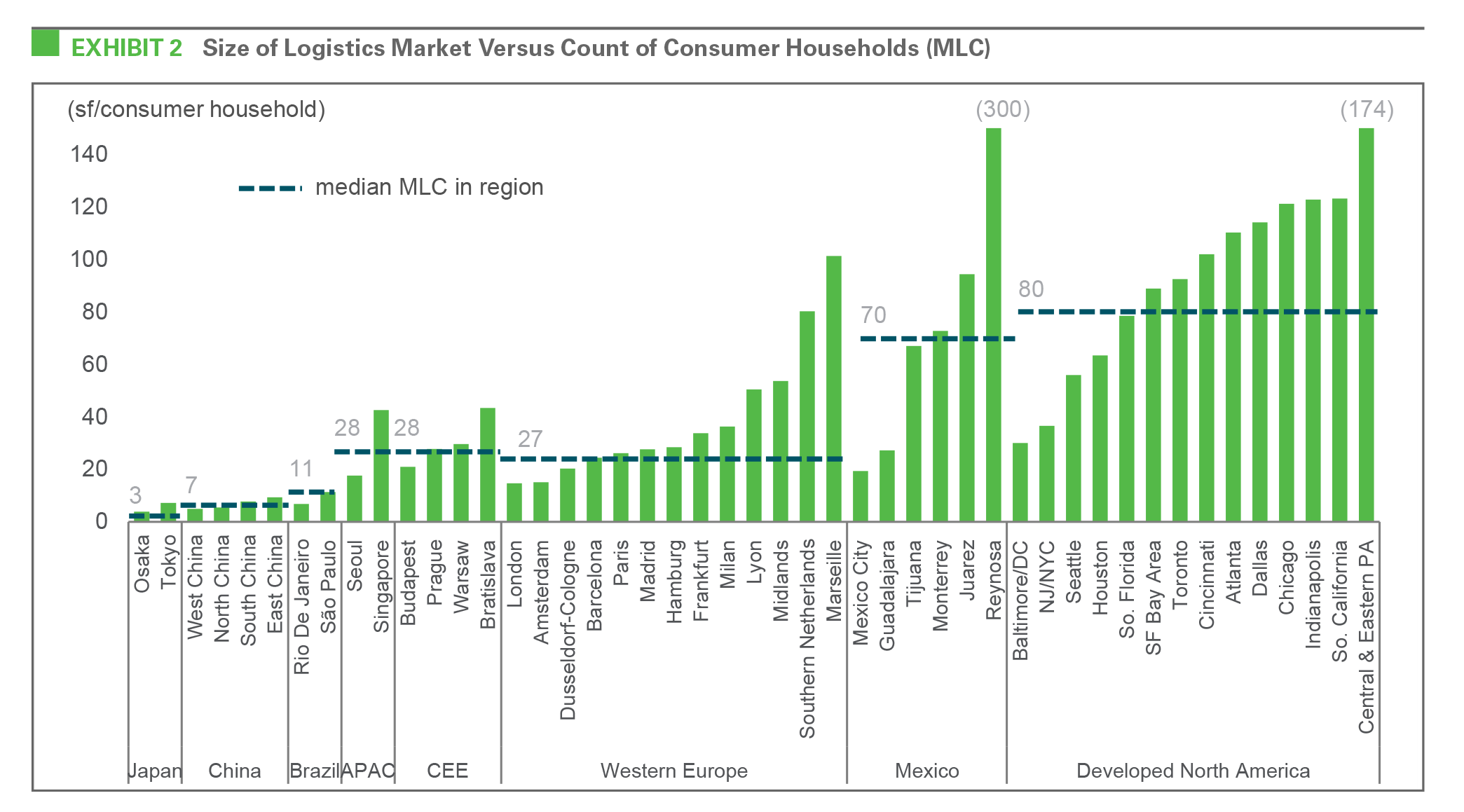
Our analysis also measures the relative competitiveness of trade-oriented logistics clusters. We refer to this indicator as the Modern Logistics Quotient (MLQ), defined as the MLC for a local cluster divided by the median MLC for the broader regional supply chain. As an example, modern stock per consumer household in Southern California is 123 sf/household.3 The median modern stock per consumer household for 42 major logistics markets in North America is 77 sf/household.4 Therefore, modern logistics stock is 60% more concentrated (123/77) in Southern California than the broader regional average and equates to a 1.60 MLQ. In our view, a ratio greater than 1.0 indicates that a local cluster is most likely a net exporter of logistics services, and that demand for logistics real estate is driven by a distribution region that extends beyond the local consumer base. Based on this data, an MLQ greater than 1.20 is a highly competitive trade-oriented cluster.
We review the relative size differences of logistics clusters in the following section and offer insight into how these clusters will grow.
III. SUPPLY CHAINS IN DEVELOPED ECONOMIES
Logistics clusters in the United States fall into two categories:
- Clusters in which demand is oriented toward population centers
- Clusters in which demand is driven by access to global trade routes
Markets oriented toward population centers typically have an MLC close to the national median of 77 sf/ household. Southern Florida is an example of a global market in which demand is driven primarily by local consumerism (1.0 MLQ).5
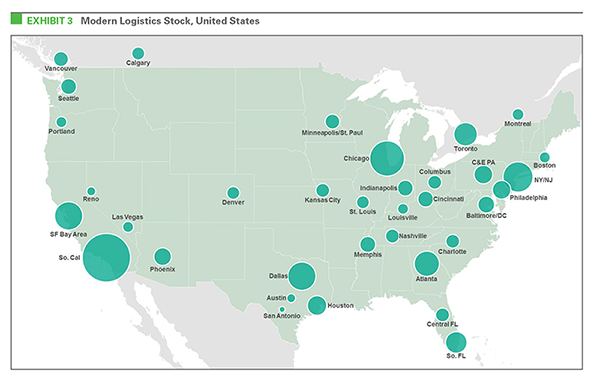
Demand for logistics space in clusters oriented toward global trade patterns includes the fastest growing big box markets in the United States. Typically, demand for big box logistics facilities is driven by global trade patterns and national or broad regional distribution. For example, the rise of the Inland Empire logistics market in Southern California was driven in large part by higher quantities of imported goods from Asia for distribution across the U.S. Atlanta, meanwhile, benefitted from population growth in the Southeastern part of the country. Since 2000, just five broad clusters in the U.S. have accounted for nearly 60% of the largest logistics real estate facilities (>500K sf) delivered to market.6 These big box clusters each possess an MLQ score significantly greater than 1.0, placing them among the highest MLQ scorers in the world: Central and Eastern Pennsylvania (2.3), Southern California (1.6), Chicago (1.6), Dallas (1.5) and Atlanta (1.4).7 These trade-oriented markets have access to high-quality highways, seaports (Southern California in particular), airports and rail intermodals.
Despite similar levels of economic maturity, the drivers of European logistics clusters are distinct. European logistics clusters continue to benefit from the structural reconfiguration of the continental supply chain. The MLC for Europe’s major metro areas is 27 sf/ household—significantly below that of North America (77 sf/household).8 Although the Southern Netherlands maintains one of the highest modern stock per consumer household in Northern Europe, bestowed by its access to the Port of Rotterdam, the cluster’s MLC (80 sf/household) is substantially below comparable U.S. trade-oriented markets. In addition, although the United Kingdom’s supply chain is among the most advanced in Europe, it is significantly underdeveloped by U.S. standards. As an example, the MLC in the Midlands is only 54 sf/ household. Regional differences such as owner/user preferences, barriers to supply and infrastructure will lead to differences between normalized regional MLCs. In Prologis’ view, the growth of modern logistics stock could be 50% higher in Europe versus the U.S.
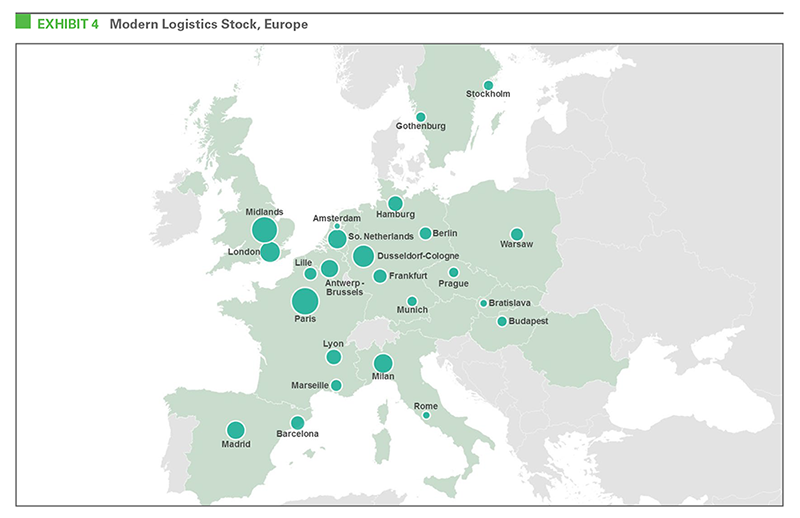
We see similar trade- and consumer-oriented logistics clusters in Europe. The Southern Netherlands and the Midlands are among the largest clusters in Europe; they also maintain the highest MLQs in Europe, at 3.0 and 2.0, respectively. Demand for distribution and light manufacturing in the Midlands is similar to the underlying drivers of demand in Chicago, benefitting from proximity to a high-cost population center and geographic positioning along a global trade route. Paris is the largest logistics cluster in Europe. Because demand for logistics space in Paris is oriented toward local consumption, the MLC for Paris (26 sf/household) aligns with the median for Western Europe. Modern stock per consumer household should continue to rise in Paris because many logistics real estate customers there are now in Class-B (or obsolete) facilities but eventually will need higher-quality buildings. Similar to Paris, the broader Dusseldorf-Cologne area is among Europe’s largest logistics clusters, but its modern stock per consumer household is below the continental average. Many customers still use obsolete and Class-B facilities in these markets (they adapt to functionally challenged facilities simply because of their superior infill locations), but they are evaluating and upgrading their real estate footprints on an ongoing basis.
Logistics clusters in Southern Europe – Milan, Marseille and Lyon in particular – support global trade patterns. Although only a moderately sized market, Marseille has the highest MLC in Europe, at 101 sf/household. Demand there is driven by proximity to an international port (i.e., Port of Marseille Fos). In addition, the MLCs in Lyon (50 sf/household) and Milan (36 sf/ household) are among the highest in Europe, driven by broader distribution across Southern Europe. Because these markets benefit from the reconfiguration of the continental supply chain, each has an elevated MLQ and an overall elevated growth rate of demand.
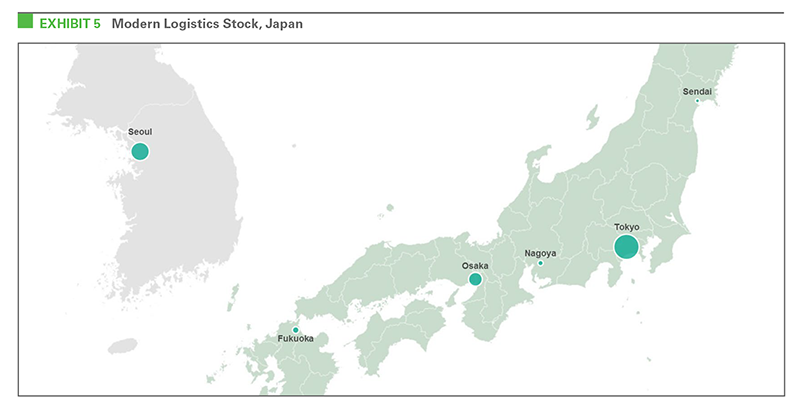
Similar to Europe, demand for logistics stock in Japan is driven primarily by a structural supply chain reconfiguration. The total industrial market in Tokyo has only recently risen above 100M sf9 and is now comparable in size to Phoenix — a market with a consumer population less than one-tenth the size of Tokyo’s (and equal to 15 million fewer consumer households).10 The MLC in Tokyo is 7.1 sf/household11, which is below less affluent emerging markets in East and South China. Legacy real estate decisions surrounding an orientation to domestic manufacturing, versus current-day international distribution, have been a moderating influence for change. Given the advancement of modern supply chains in Europe and Japan, these logistics real estate markets have been among the fastest growing globally (after normalizing for their respective sizes) despite slow demographic and economic growth in each region. Larger national businesses will likely continue to trade lower-quality distribution space for modern upgrades. The implementation of business continuity plans has been a catalyst for change, in Prologis’ view. Logistics real estate customers in Japan increasingly value modern buildings with less seismic risk in the wake of the 2011 Tohoku earthquake and tsunami. Although Tokyo’s logistics real estate market is small by global norms, the logistics cluster maintains the highest MLQ in the nation (2.1). New and expanded loop expressways that encircle the core of Tokyo – such as the Tokyo Gaikan and Ken-O expressways – have played important roles in the growth of supply-constrained Tokyo, and they provide development opportunities in periphery submarkets. Similar to the U.S., logistics demand in Japan’s regional markets is driven mostly by local consumption, and thus the MLQs in Fukuoka and Sendai are nearly 1.0. Nagoya remains the most underdeveloped logistics cluster in Japan (1.6 sf/household).12 This cluster competes with Tokyo and Osaka for local distribution but has been buoyed by demand from automobile parts suppliers to service Toyota.
Japan’s logistics markets may never reach MLC levels comparable to the U.S., as the country is supply-constrained and among the most expensive logistics markets in the world, but the wide variance in MLCs suggests that Japan’s logistics markets could be severely underdeveloped.
IV. DEVELOPING LOGISTICS CLUSTERS IN EMERGING MARKETS
The rise of consumerism in emerging markets such as China, Central and Eastern Europe (CEE) and Latin America is a structural growth driver. Cyclical macroeconomic trends are relevant only when they pose a downside risk to the market’s longer-term socioeconomic growth profile. To illustrate, affluent consumer households in China are expected to increase from approximately 155 million in 2015 to approximately 290 million by 2025, nearly doubling over ten years.13 Due to this rapid rise in affluence, consumer spending on logistics-intensive goods, which can be defined as durable goods that typically move through a warehouse or distribution center, is expected to increase from $4,000 per capita to nearly $8,000 by 2025.14
Over the next decade, logistics real estate markets in fast growth and maturing megacities across the emerging markets in our study are poised to benefit from the structural rise of their corresponding middle classes. For example, East China, Mexico City and São Paulo are already among the largest consumer markets in the world, with 10.2M, 4.4M and 4.4M consumer households, respectively.15 Nevertheless, the growth of modern stock per consumer household has risen gradually over the last five years in these clusters as the logistics real estate development cycle struggles to keep pace with the rise of the middle class. As a result, these logistics clusters are among the most underdeveloped markets in the world. In turn, they enjoy some of the fastest growth rates of demand. With its relatively long history of institutional development, Mexico City’s MLC is the highest among the emerging markets megacities and yet is only at 19 sf/ household.16 To compare, São Paulo and the major Chinese markets possess 10 sf/household or less.17 Historically, many EMs have been primarily owner-user markets, and customers are only now beginning to favor higher quality and leasable space, which should propel the modernization of supply chains.
Trade plays an important role in shaping certain logistics clusters. Demand along the Mexican border is driven almost exclusively by trade patterns. MLCs in smaller regional distribution markets along the Mexican border are among the highest in the world, led by Reynosa (300 sf/household), Juarez (94 sf/household) and Tijuana (67 sf/household).18 Although the logistics clusters along the Mexican border are relatively small (each cluster has between 20 and 30M sf19 of stock), they benefit from the reshoring of manufacturing to North America, prompted by low relative labor unit costs and the distribution of merchandise, such as electronics and automobiles, to the U.S. The north-south Pan-American Highway that connects Mexico City to the border crossing at Laredo, Texas – the largest inland port in the U.S. – is a key demand driver for Mexico logistics clusters, as the route serves as the primary freight lane to the U.S. Between 1996 and 2014, loaded truck and rail container traffic increased by compound annual growth rates of 5.5% and 7.5% and reached nearly 1.5M and 260K TEUs in 2014, respectively.20
A comparable trend exists in Central and Eastern Europe. The most notable markets include Poland, as modern logistics stock in the country’s ten main markets totals nearly 100M sf, making it the largest modern logistics market in CEE.21 The median MLC in CEE (28 sf/household) is slightly greater than the median level for Western Europe. This likely reflects the importance of trade in CEE markets, though it is offset by the relatively low adoption of modern logistics facilities in the emerging markets. Cost-competitive Central and Eastern Europe continues to grow as a key distribution gateway, driven by a local labor-intensive and value-add manufacturing base. Of note, Bratislava has the largest MLQ in the region (1.6), but the market contains less than 15M sf of logistics stock.22
V. IMPLICATIONS FOR LOGISTICS REAL ESTATE
Connecting the dots around the world is critical to understanding how logistics clusters will grow. Trends in the U.S. are an indicator of how European and Japanese markets could develop in time. More specifically:
- Most European clusters have less than half of modern stock compared to comparable U.S. clusters when normalizing for the local consumer base. Europe’s logistics real estate recovery has proceeded ahead of the economic recovery due to demand growth from customers upgrading from obsolete to modern stock. Looking ahead, additional development is likely as the share of customers seeking modern stock rises.
- Tokyo and Osaka have very low levels of supply relative to the local population and economy (the world’s largest economic zone), and therefore the supply pipelines are among the most active in the world. Additional outsized growth is likely.
Outsized demand growth in emerging markets should persist despite economic crosscurrents in many of those markets. In time, benchmarks in Europe may be an indicator of future development in emerging markets. In the medium term, benchmarks such as Mexico City and Seoul could be useful reference points for other severely undersupplied clusters, such as those in China and Brazil, which illustrates that these clusters need to double or triple in size to approach global standards. The power of undersupply is in sharpest relief in clusters in China and especially in São Paulo, a challenged economy but one with positive logistics real estate demand and a Class-A vacancy rate below 5%.23
Recognizing the evolution of global logistics clusters can bring a better understanding of opportunities in emerging and developed economies. Our analysis is a snapshot of the current development arc of regional supply chains. In Prologis’ view, the MLC indicator is a useful tool for identifying development opportunities, particularly in emerging markets and the developed economies of Europe and Japan with modernizing supply chains, using global standards as guideposts. Still, risks associated with these indicators exist. The modernization of the supply chain in Japan and Europe depends on logistics real estate customers’ continued migration to modern facilities as they seek to reduce costs and boost efficiency. The MLQ identifies the underlying drivers of demand in logistics clusters and differentiates by those oriented toward local consumption or global trade routes, and the relative opportunities and risks associated with both trends.
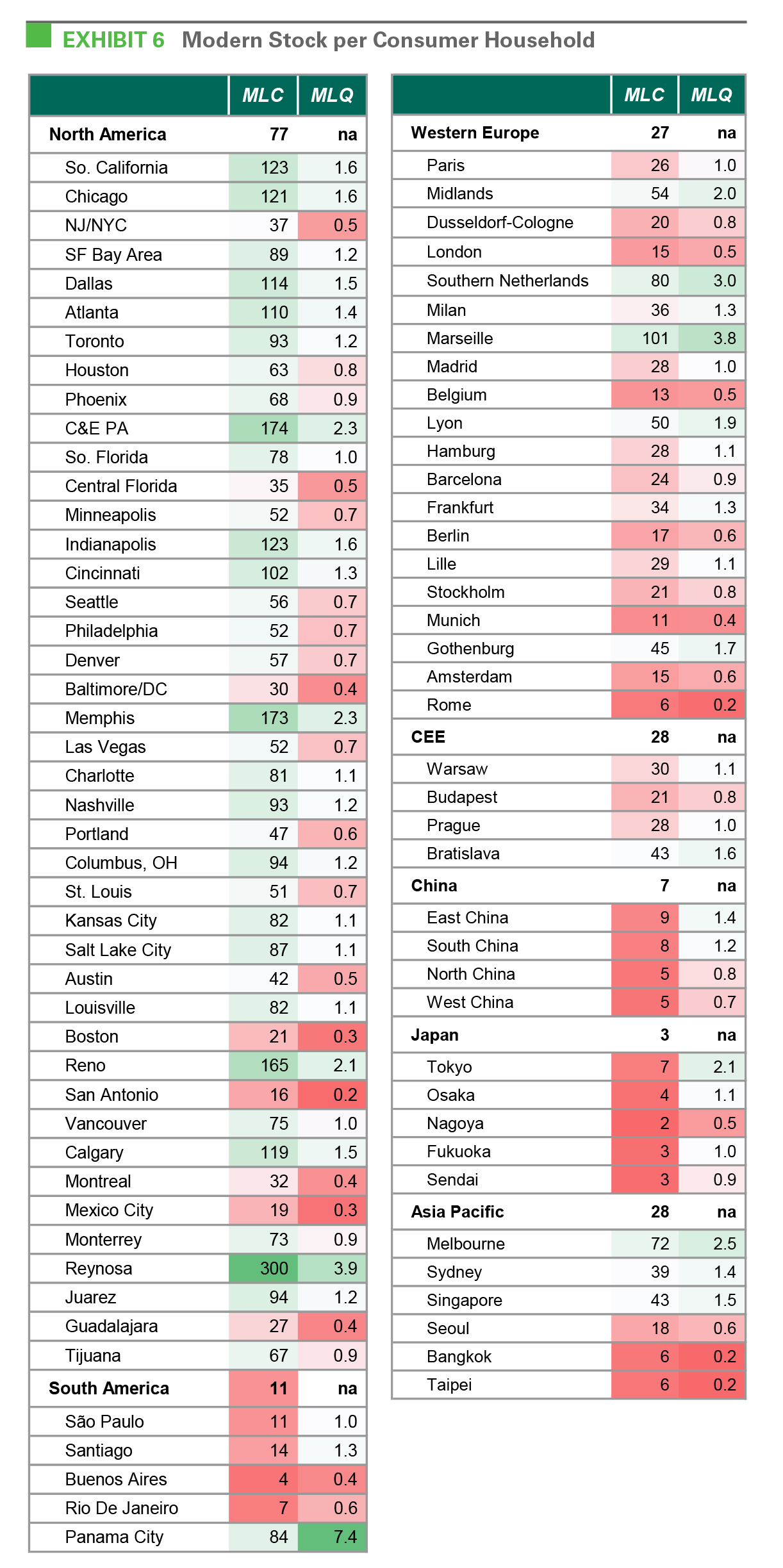
ENDNOTES
- Logistics Clusters: Delivering Value and Driving Growth; Sheffi, Yosef
- JLL, Prologis Research
- CBRE Research, Prologis Research
- CBRE Research, Oxford Economics, Prologis Research
- CBRE Research, Oxford Economics, Prologis Research
- CBRE-EA, Prologis Research. The broad New Jersey/New York and Central & Eastern PA corridor is classified as one region for big box distribution.
- CBRE, Cushman & Wakefield, Colliers, Oxford Economics, Prologis Research
- CBRE, JLL, Gerald Eve, DTZ, Cushman & Wakefield, Colliers, Oxford Economics, Prologis Research
- CBRE Research, Prologis Research
- Oxford Economics, Prologis Research
- CBRE Research, Oxford Economics, Prologis Research
- CBRE Research, Oxford Economics, Prologis Research
- Oxford Economics, Prologis Research
- Oxford Economics, Prologis Research
- Oxford Economics, Prologis Research
- CBRE Research, Oxford Economics, Prologis Research
- CBRE Research, JLL, Oxford Economics, Prologis Research
- CBRE Research, Oxford Economics, Prologis Research
- CBRE Research
- Bureau of Transportation Statistics, US Department of Transportation
- CBRE Research
- CBRE Research
- CBRE Research
KEY DEFINITIONS
Logistics Cluster: An agglomeration of distribution centers concentrated to serve local consumption and/or global trade routes. Often, logistics clusters operate irrespective of governmental boundaries. This means that a cluster might include multiple markets or metropolitan statistical areas.
Modern Logistics Concentration (MLC): The ratio of modern logistics stock divided by the number of households with an annual income greater than $20,000 US$ (after adjusting for inflation and purchasing power parity) in a given logistics cluster.
Modern Logistics Quotient (MLQ): The MLC for a logistics cluster divided by the median MLC for all logistics clusters in the broader regional supply chain. An MLQ greater than 1.20 signifies a highly competitive trade-oriented cluster.
FORWARD-LOOKING STATEMENTS
This material should not be construed as an offer to sell or the solicitation of an offer to buy any security. We are not soliciting any action based on this material. It is for the general information of customers of Prologis.
This report is based, in part, on public information that we consider reliable, but we do not represent that it is accurate or complete, and it should not be relied on as such. No representation is given with respect to the accuracy or completeness of the information herein. Opinions expressed are our current opinions as of the date appearing on this report only. Prologis disclaims any and all liability relating to this report, including, without limitation, any express or implied representations or warranties for statements or errors contained in, or omissions from, this report.
Any estimates, projections or predictions given in this report are intended to be forward-looking statements. Although we believe that the expectations in such forward-looking statements are reasonable, we can give no assurance that any forward-looking statements will prove to be correct. Such estimates are subject to actual known and unknown risks, uncertainties and other factors that could cause actual results to differ materially from those projected. These forward-looking statements speak only as of the date of this report. We expressly disclaim any obligation or undertaking to update or revise any forward-looking statement contained herein to reflect any change in our expectations or any change in circumstances upon which such statement is based.
No part of this material may be (i) copied, photocopied, or duplicated in any form by any means or (ii) redistributed without the prior written consent of Prologis.
PROLOGIS RESEARCH
Prologis’ research department studies fundamental and investment trends and Prologis’ customers’ needs to assist in identifying opportunities and avoiding risk across four continents. The team contributes to investment decisions and long-term strategic initiatives, in addition to publishing white papers and other research reports. Prologis publishes research on the market dynamics impacting Prologis’ customers’ businesses, including global supply chain issues and developments in the logistics and real estate industries. Prologis’ dedicated research team works collaboratively with all company departments to help guide Prologis’ market entry, expansion, acquisition and development strategies.
ABOUT PROLOGIS
Prologis, Inc. is the global leader in industrial real estate. As of June 30, 2015, Prologis owned or had investments in, on a wholly owned basis or through co-investment ventures, properties and development projects expected to total approximately 670 million square feet (62 million square meters) in 21 countries. The company leases modern distribution facilities to more than 5,200 customers, including third-party logistics providers, transportation companies, retailers and manufacturers.
Copyright © 2015 Prologis, Inc. All rights reserved.

